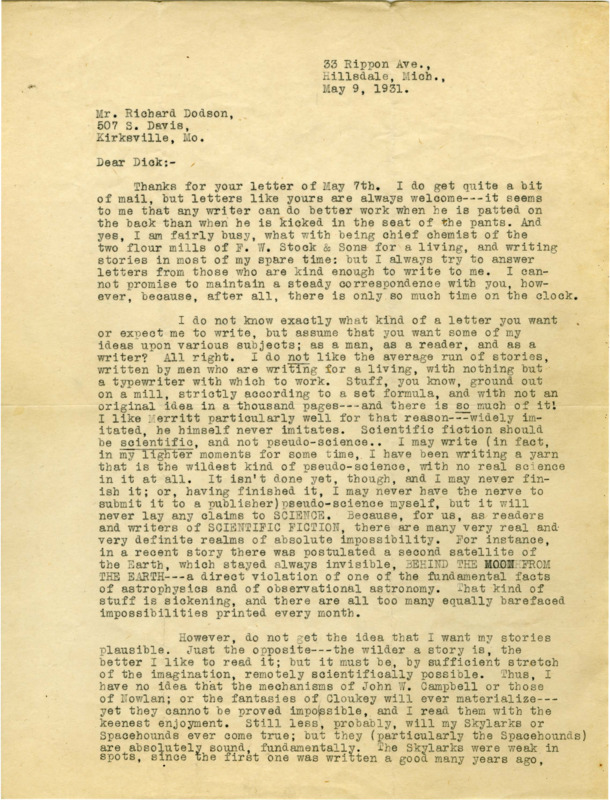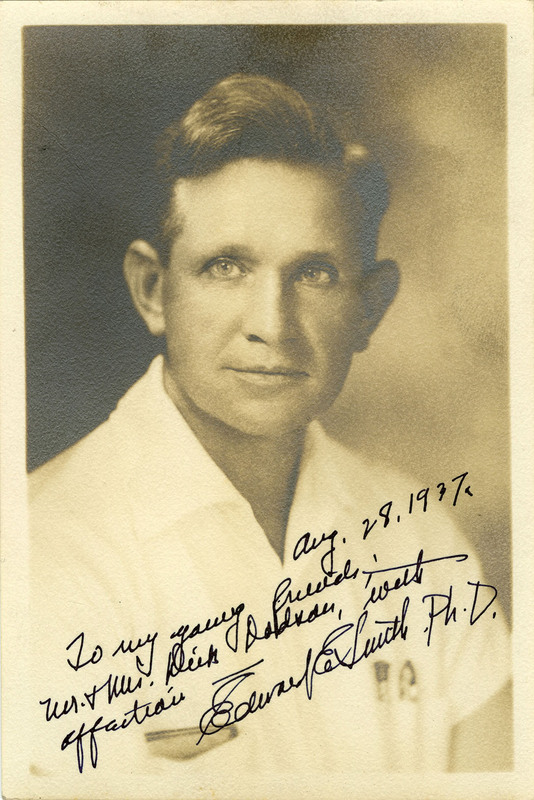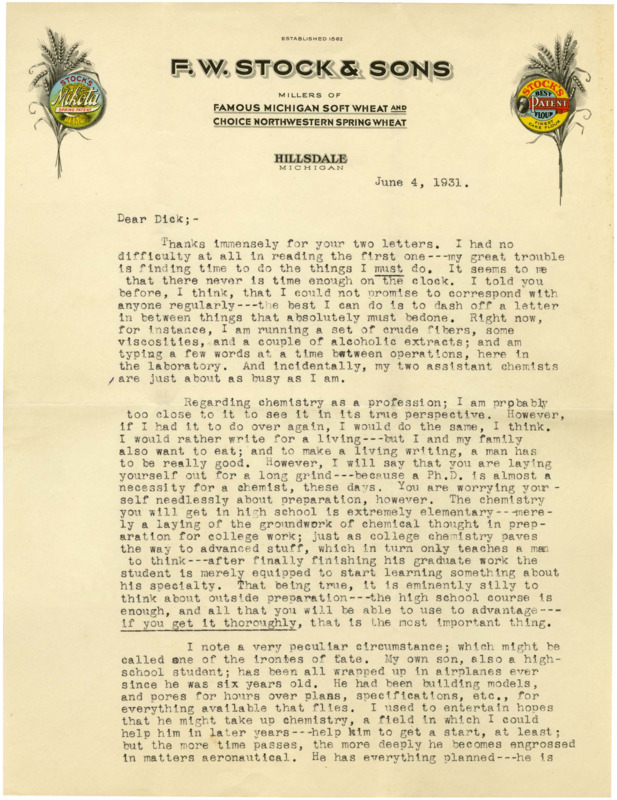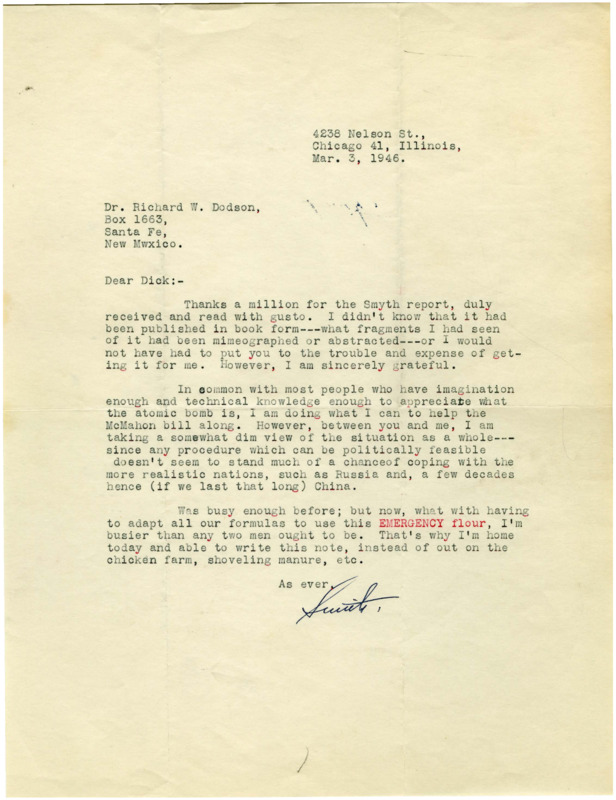Richard W. Dodson Collection of Science Fiction
Correspondence between Richard W. Dodson, Edward E. ("Doc") Smith, and other science fiction authors of the 20th century
Contents: About the Collection | Science Fiction Correspondence | About Doc Smith | About Richard Dodson | Tech
About the Collection
This digital collection consists of a selection of digitized materials which were originally collected by Richard Dodson during his correspondence with science fiction authors, fans, and periodical editors between 1905 - 1949. Much of the collection documents his correspondence with E.E. “Doc” Smith.
The full Richard Dodson Collection on E. E. “Doc” Smith and Science Fiction, 1931-1949 is held by the University of Idaho’s Special Collections and Archives, libspec@uidaho.edu.
Science Fiction Correspondence
The Richard W. Dodson Collection of Science Fiction provides a classic example of the interaction of science fiction readers with the genre’s writers and editors during the 1930s, an interaction facilitated by magazine editors who published author’s stories, names, and addresses in science fiction magazines. Historically, this interaction resulted in the publication of hundreds of amateur magazines (fanzines), the first locally organized fan clubs and, ultimately, the First World Science Fiction Convention, held in New York City in 1939.
Like many young fans, Richard Dodson’s (1915-2008) interest in both science and in fiction led to correspondence with writers, editors and other fans via these magazines. While this collection contains fascinating correspondence with Abraham Merritt, Clark Ashton Smith, Eric Rocker Eddison, and Julius Schwartz, among others, the heart of the collection is the remarkable material pertaining to Edward Elmer “Doc” Smith, Dodson’s favorite author.
As a high school student, Dodson read several of Smith’s stories in the Amazing Stories and Astounding magazines, and was inspired to write to him. The result was an exchange of letters with topics ranging from the nature of science fiction writing and critiques of Smith’s work to the study of science that would continue for the next twenty years.
About Doc Smith
Edward Elmer “Doc” Smith (1890-1965) was an American chemist and pioneer science fiction writer. While Doc Smith’s name may be virtually unknown to fans of contemporary science fiction, Smith’s influence on the development and scope of the field is undeniable.
With the publication of his book The Skylark of Space in 1928, Smith introduced the concept of interstellar travel and created the much-imitated science fiction genre known as the space opera. Space operas are characterized by interstellar wars waged among galactic empires, conflicts that involve advanced technology and consume entire worlds, often lasting hundreds of years. The Skylark of Space and his stories that followed significantly expanded the boundaries of pulp superscience yarns by humanizing the scientist/hero, making science relevant to the plot, and moving the action beyond the confine of the solar system.
He became a master of the form:
After Smith, all science fiction bore the stamp of his influence, most clearly, in the writing of Jack Williamson and John W. Campbell, Jr., but in many other writers’ work as well… That influence endures to the present. At a panel during the 1982 World Science Fiction Convention a group of writers including Larry Niven, Jack Chalker, Phylis Eisentein and Michael Resnick agreed that they stand on the shoulders of earlier writers, in particular Doc Smith because of his positive belief in the future as a place where humans will be free to take significant action. Thus, Smith’s identification with the scientist, or rather the spirit of optimistic rationality that he attributes to science, has become one of the foundations of science fiction.
Smith’s influence is also evident in film and TV, from Star Trek and Star Wars to Guardians of the Galaxy.
As a chemist, Smith was situated firmly within the tradition of Jules Verne and H. G. Wells in that he made an effort to provide at least some plausible science in his scientific romances. In this, he differed from some other writers of the time who wrote “science fantasy” rather than science fiction.
When John W. Campbell Jr. became editor of the science fiction magazine Astounding in 1937, his editorial policy called for realism and scientific verisimilitude. With his engineering background and his appreciation of “hard” science fiction stories written by fellow writers with science backgrounds, Campbell ushered in what is now considered science fiction’s “golden age.” The need to employ at least somewhat plausible science while telling the story is a connecting thread throughout the correspondence between Smith and Dodson.
About Richard Dodson
As a teenager, science was as important a part of Dodson’s life as it had been for Smith. Dodson enrolled in the California Institute of Technology (Cal Tech) in Pasadena where he was one of Linus Pauling’s assistants. He graduated with a B.S. in Chemistry in. 1936, then went to Johns Hopkins University from which he received his Ph.D. in Chemistry.
Dodson’s research focus was in radioactive materials and in 1943 he joined the Los Alamos National Laboratory to work on the Manhattan Project.
After the war Dodson returned to Cal Tech, but soon left for Columbia University where he joined the Chemistry Department, first as an assistant professor, later as a full professor. At this time he also worked for the newly established Brookhaven National Laboratory where he was appointed first chair of the Chemistry Department. He served as well on General Advisory Committee of Atomic Energy Commission.
Technical Credits - CollectionBuilder
This digital collection is built with CollectionBuilder, an open source framework for creating digital collection and exhibit websites that is developed by faculty librarians at the University of Idaho Library following the Lib-Static methodology.
Using the CollectionBuilder-CSV template and the static website generator Jekyll, this project creates an engaging interface to explore driven by metadata.




